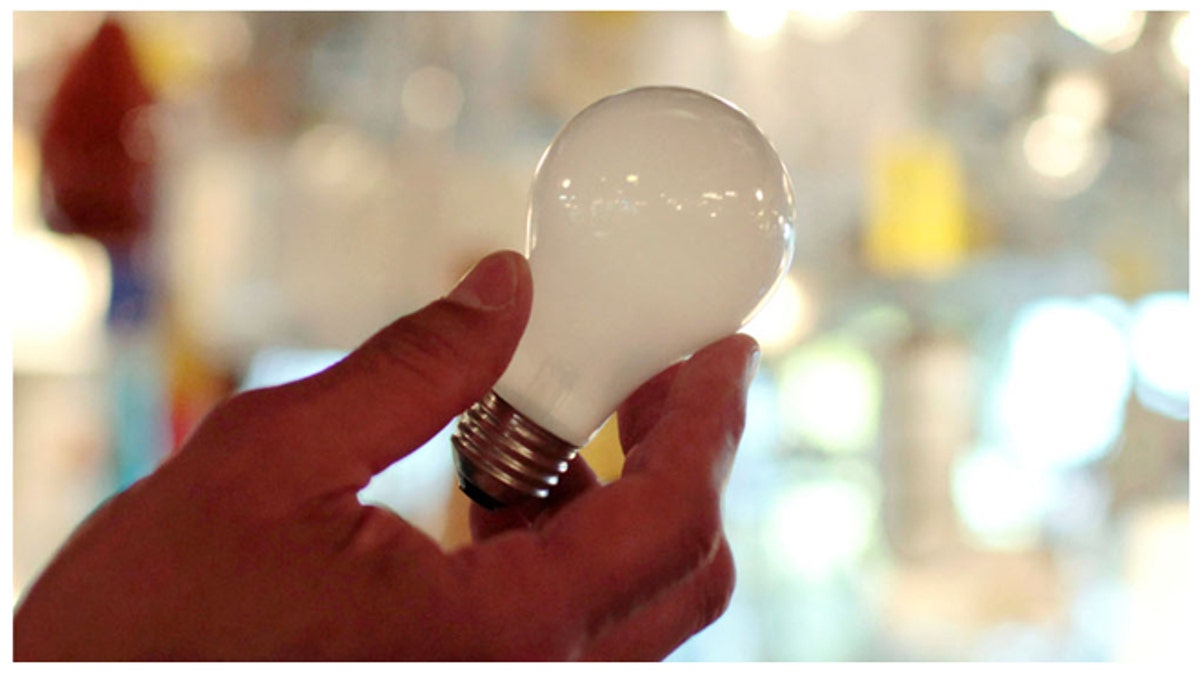
A 100-watt incandescent light bulb seen at Royal Lighting in Los Angeles on Jan. 21, 2011 -- before the bulbs were banned by a 2007 law. (AP Photo)
When the ball drops on New Year’s Eve, the year ends -- and so does the ordinary lightbulb.
Jan. 1. marks the end of a seven-year effort to outlaw the ordinary lightbulb, thanks to a 2007 law that raised minimum efficiency standards for traditional incandescent bulbs far beyond what the technology can manage.
It’s lights out for the traditional light bulb, in other words, which was essentially killed by that bill.
“The government started phasing out incandescents in 2012, starting with the 100-watt bulb, and then followed by the 75-watt,” explained Melissa Andresko, communications director for lighting-automation company Lutron.
“Come January 1, both the 60- and the 40-watt bulbs are going away. And that’s really going to have the most impact on consumers because those are the most popular incandescent bulb types right now,” she told FoxNews.com earlier this month.
[sidebar]
The demise of the incandescent bulb might come as a surprise to most Americans, however. A recent study by Lutron pointed out that fewer than 1 in 3 adults (just 28 percent) were aware of the planned phase out. A similar Socket Survey by Sylvania showed slightly more awareness -- 4 in 10 were aware of the phase out, it revealed.
Contrary to some reports, the 2007 law doesn’t mandate that manufacturers discontinue their bulbs, just that they improve them: 40W bulbs must draw just 10.5W, and 60W bulbs 11W. TWhe result is the same: Incandescents simply can’t keep up with those twisty compact fluorescent (CFL) and newer LED bulbs, and even retailers are buying in bulk as the calendar winds down.
Home Depot has a six-month stockpile, according to Mark Voykovic, the store’s national light bulb merchant.
“Home Depot anticipates running out of their stock of 40W to 60W bulbs six months into 2014,” he told FoxNews.com in early December. Conservative policy group The Heritage Foundation recently posted a lament for the lightbulb, noting that folks should stock up before they miss out.
“The federal government is taking decisions out of the hands of families and businesses, destroying jobs, and restricting consumer choice in the market. We all have a wide variety of preferences regarding light bulbs. It is not the role of the federal government to override those preferences with what it believes is in our best interest,” wrote Nicholas Loris.
While consumers might not appreciate the drop in choices, they should like their plunging energy bills, said the National Electrical Manufacturers Association -- the main trade association for bulb builders.
“NEMA’s members are in the energy efficiency business,” Phallan Davis, a spokeswoman for NEMA, told FoxNews.com. “Electroindustry products are becoming more and more energy efficient and the systems that often manage their use add to energy and cost savings. NEMA believes that energy efficiency policies, for the residential, commercial, and industrial sectors, should be a central component to any national energy policy,” she said.
Many nonetheless lament the confusing terminology of color temperatures that dictates whether CFLs emit a pale blue (5,000-6,500 Kelvin) or whiter (3,500-4,100K) light, neither of which quite matches the familiar light of an incandescent light bulb (2,700-3,000K). Savvy interior decorators were hoarding as early as two years ago.
“Every time I go to Costco, I buy more wattage,” decorator Bunny Williams told The New York Times in 2011. She said she couldn’t abide the sickly hue of a twisty compact fluorescent, the paper reported.
CFLs, one of the most common energy-efficient replacements for incandescents, have grown in popularity at the same time that colors have improved. LED-based bulbs, including newer models by manufacturers Cree and Philips, are at the forefront of bulb technology’s future.
They’re also a pricey replacement, consumers are finding, despite dramatic price cuts over the past year. Home Depot sells a six pack of 60-Watt incandescents from GE for $4.67, or 78 cents apiece. A six-pack of 60-Watt LEDs from Cree sells for an eye-watering $77.82 -- $12.97 each. The tradeoff is the dramatic drop in power consumption and the much longer lifespan of the newer technologies, which can last up to 15 times longer.




















